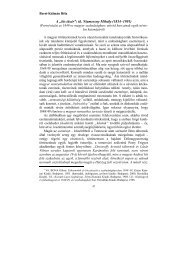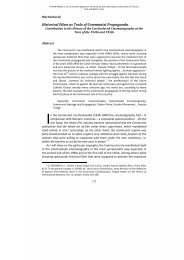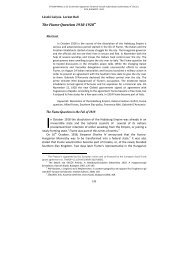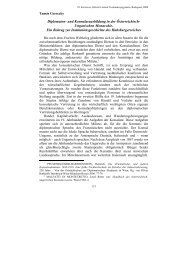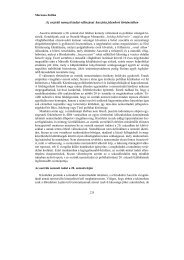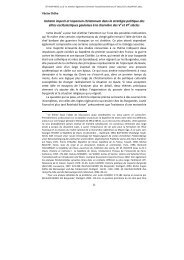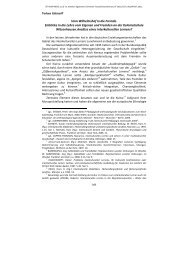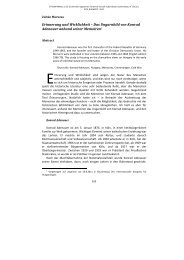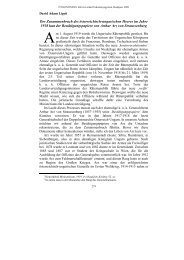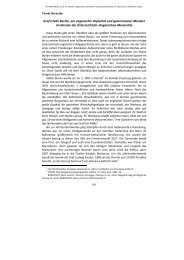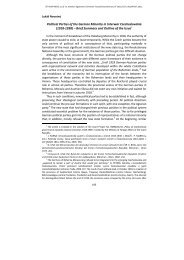The Molotov-Ribbentrop Pact - ELTE BTK Történelem Szakos Portál
The Molotov-Ribbentrop Pact - ELTE BTK Történelem Szakos Portál
The Molotov-Ribbentrop Pact - ELTE BTK Történelem Szakos Portál
You also want an ePaper? Increase the reach of your titles
YUMPU automatically turns print PDFs into web optimized ePapers that Google loves.
Delmouly, Laura<br />
<strong>The</strong> German-Soviet pact in french coursebooks<br />
„<strong>The</strong> German Russian agreement can be justified if you look at it from the<br />
angle of the interested powers, but it did mean a war in the West” 1 . This<br />
quotation is mentioned in a History school book from 1947, and the agreement<br />
seems to be the most concrete action that will lead to war.<br />
A study on the Nazi-Soviet <strong>Pact</strong> in the French school books allows us to ask<br />
ourselves how this historical fact was perceived. How was this event taught<br />
from 1945 till today? For this we will use examples out of books edited from<br />
1945 till today: 5 books were used between 1945 and 1960, 2 for the years<br />
1960 till 1970, 2 for the eighties, 4 for the nineties and finally 3 for the years<br />
2000. However, these books come from different editors (Nathan, Hatier,<br />
Hachette and so forth), and as the school market is private and the books<br />
chosen by the teachers, not every student uses the same book. Nevertheless<br />
right after the war the school books include in their pages the conflict, the facts<br />
until the victory of the Allied. <strong>The</strong>refore the <strong>Molotov</strong>-<strong>Ribbentrop</strong> agreement<br />
takes an important place in explaining the conflict to the students. Although the<br />
war is taught to every French student, it isn’t studied at all levels and the<br />
programs have often changed. Out of the 16 books that talk about the conflict<br />
one is used in primary school (that is 6 years old), 2 are for the students who<br />
are 13/14 years old, 2 for the 14/15 years old, 5 for the 16/17 years old, 2 for 18<br />
years old used in their last year of high school and then 4 used at a University<br />
level. Automatically there is a difference in the explanation of the agreement<br />
according to the age of the student and its level. Also, the school book is often<br />
a tool and not systematically used by the teacher.<br />
Equally it is important to mention the fact that school books endure the<br />
current dominating standards during their edition which has an impact on the<br />
way of teaching. What was the place given to the <strong>Molotov</strong>-<strong>Ribbentrop</strong><br />
agreement in the programs? How was this event taught? Was the agreement<br />
influenced by the different historical events? We will study the way the<br />
agreement was taught right after the war and than we will show a change in the<br />
seventies in the way of perceiving the agreement. <strong>The</strong>n finally we will present<br />
the way the German-Russian treaty was studied in order to reflect on<br />
totalitarianism.<br />
<strong>The</strong> name itself of the <strong>Molotov</strong>-<strong>Ribbentrop</strong> agreement has known a number<br />
of different versions; the name Nazi-Soviet <strong>Pact</strong> or <strong>Molotov</strong>-<strong>Ribbentrop</strong><br />
agreement emerges in the seventies. <strong>The</strong> names that were used during the two<br />
former decades where they talk about „treaty” or „German-Russian<br />
1 GENET, Louis: L’Epoque contemporaine 1848-1939, classes préparatoires de philosophie<br />
et de mathématique. A. Hatier, Paris, 1946, 830-831.<br />
143



